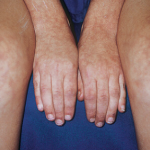Welcome back! Last week we talked about DNA testing. If you missed that blog and would like to catch up, click HERE.

Some of you reached out after last week’s blog asking for more information about Antiphospholipid Antibody Syndrome. Even though I carry the diagnosis, I had to do some research to study up on it so that I could give you accurate information. The following blog is what I found on the subject.
Antiphospholipid Antibody Syndrome is a mouthful, isn’t it? I much prefer some of it’s other names:
- Anticardiolipin antibody syndrome, or aCL syndrome
- Antiphospholipid syndrome
- aPL syndrome
- Hughes syndrome
- Lupus anticoagulant syndrome
Source: National Heart, Lung, and Blood Institute, National Institutes of Health
The National Organization for Rare Disorders (NORD) states that, “Antiphospholipid syndrome (APS) is a rare autoimmune disorder characterized by recurring blood clots (thromboses)”.
When it comes to the causes of this syndrome, NORD gave us some insight. “The antibodies that are present in APS are known as antiphospholipid antibodies. These antibodies were originally thought to attack phospholipids, fatty molecules that are a normal part of cell membranes found throughout the body. However, researchers now know that these antibodies mostly target certain blood proteins that bind to phospholipids. The two most common proteins affected are beta-2-glycoprotein I and prothrombin. Researchers believe that multiple factors including genetic and environmental factors play a role in the development of APS. In rare cases, APS has run in families suggesting that a genetic predisposition to developing the disorder may exist“.
In my particular case, our family has a long history of blood clots. I have several aunts and cousins who have had clots (or died from clots), my mama had a clot that blinded her in one eye, and the same thing recently happened to my sister. My cousin died from a suspected clot at the age of 52. He complained of a headache, went down to his basement to play his guitar, and died.
Only a couple of months before his death, I experienced severe pain in my left thigh while working. My coworker insisted I go to the ER and her quick thinking may have saved my life. I had a clot (at 52 years of age) and according to the ER doctor, it was poised to go up into my lungs. This is referred to as a pulmonary embolism. Pulmonary embolism may cause breathlessness, sudden pain in the chest, exhaustion, high blood pressure of the pulmonary arteries, or sudden death.
While clots are the single most common expression of this syndrome, it also comes with other less recognized symptoms such as:

- Skin rashes and other skin diseases. These include blotchy reddish patches of discolored skin, a condition known as livedo reticularis. In some cases, sores (ulcers) may form on the legs.
- Lack of blood flow to the extremities can cause loss of living tissue (necrotic gangrene), especially in the fingers or toes.
- Clot-like deposits on the valves of the heart (valvular heart disease) can permanently damage the valves. For example, a potential complication is mitral valve regurgitation (MVR). In MVR, the mitral valve does not shut properly allowing blood to flow backward into the heart. Affected individuals may also experience chest pain (angina) and the possibility of a heart attack (myocardial infarction) at an early age.
- Low levels of blood platelets (thrombocytopenia). Thrombocytopenia associated with antiphospholipid antibodies is usually mild and only rarely causes easy or excessive bruising and prolonged bleeding episodes. Affected individuals are also at risk for autoimmune hemolytic anemia, a condition characterized by the premature destruction of red blood cells by the immune system.
- Symptoms that resemble multiple sclerosis including numbness or a sensation of pins and needles, vision abnormalities such as double vision, and difficulty walking. Some data show an association of APS with cognitive dysfunction, but the mechanism is not known.
- Complications during pregnancy including repeated miscarriages, fetal growth delays (intrauterine growth retardation), and preeclampsia. Preeclampsia is a condition characterized by high blood pressure, swelling, and protein in the urine. Symptoms associated with preeclampsia vary greatly but may include headaches, changes in vision, abdominal pain, nausea, and vomiting. It is suspected that 20% of all recurring miscarriages are due to APS.
As many as one-third of cases of stroke in people under 50 years of age may be due to APS. That’s a number I don’t care to challenge. While taking a blood thinner for life is somewhat of a hassle, the consequences of not taking the medication outweigh the inconveniences. To go off of the Warfarin is to take a very large gamble, and to date, I’ve never had any luck at the casinos. It’s best to comply.
If you or someone you know has a history of strokes in their family, I urge you to contact your PCP to talk about getting a blood test. My PCP, who is also a DO, went to a lecture on this topic so she could better attend to my needs. She found out that they are now thinking this syndrome is more common than previously recorded, so it’s worth the blood test to get answers. At the very least, you would rule out one more possibility. Either way, I wish you love and health.
If you found this blog to be helpful, informative, or just a relaxing way to waste time, please do me a favor and share it on your Facebook page? To share, just click on the Facebook icon at the top of this page. Much appreciated!
good article….but good grief. You can’t even take off the worthless mask for a picture? Read the medical literature…..masks are harmful. The only thing they do is make the person wearing them sick…and proves you have not done your homework.
Many people who are taking warfarin (Coumadin) are given the advice to avoid greens in their diet. This advice has prevented many people from transitioning their diet to healthier food choices. Transitioning one’s diet to more plant food can actually improve health even for those taking blood thinners. Here is how to make the transition safely. When you were first placed on the blood thinner your blood was tested frequently for several weeks to insure you were taking the correct dose…not too little and not too much. So when adding greens to your diet…you will consult with your doctor and get tested more frequently to insure that the blood thinner dose is again adjusted to the not too much or too little range. The main concept is to eat about the same quantity of greens on a weekly basis. That means eating daily greens (spinach, kale, collards, broccoli, chard, arugula, etc.) which are healthy for you. The greens contain vitamin K which will likely require slightly higher doses of blood thinner medication. The benefits of eating more greens include extra nitric oxide (which lowers your blood pressure and keeps your artery lining healthy), increased fiber (which feeds the microbiome and the good bacteria in your intestines), plant minerals, vitamins, and other chemicals (which boost your immunity, fight off cancer cells, and protect against viruses). The disadvantage is the need to test your blood more frequently until you have completed the transition. Remember to just keep eating a similar amount of green veggies each week ..and enjoy the improved health from transitioning to a more plant based diet.